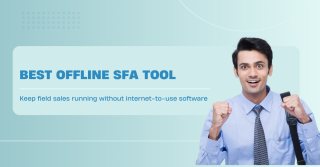How to Use Point-of-Sale Data for Smarter Market Execution?

For consumer brands today, point-of-sale (POS) data is more than just a tool for understanding sales. It’s become the foundation for smarter, faster, and more effective execution strategies in the field. By understanding when and where products are being purchased—and pairing that with in-store activity and team performance—brands can turn POS insights into powerful actions that drive growth across key accounts.
In this blog, we’ll explore how your team can use point-of-sale data not just to track performance, but to enhance execution, strengthen store relationships, and prioritize field sales resources where they’ll have the biggest impact. Whether you’re leveraging a Field Sales App or deploying advanced Field Sales Software, POS integration is the smart way to elevate execution.
What Is Point-of-Sale Data?
At its core, point-of-sale data refers to the information collected at the moment a transaction occurs. For consumer packaged goods (CPG) companies, this means identifying where, when, and how often a product is scanned and sold.
There are two primary sources of POS data:
Retailer Direct Data: Data provided directly from one specific retailer or store chain.
Syndicated Data: Aggregated sales metrics gathered from multiple retailers, typically compiled by third-party data firms.
Additionally, POS data can be analyzed through two different lenses:
Store-Level Sales Data: Helps measure performance per location or region.
Shopper Behavior Data: Offers insights into individual consumer purchasing trends.
_1745393901.png)
For market execution purposes, store-level POS data is the most relevant. It reflects the effectiveness of in-store promotions, shelf placement, and visual merchandising efforts—allowing brands to make more informed decisions about where and how to allocate Field Sales Software resources.
Why POS Data Matters in Field Execution?
When POS data is combined with field activities and in-store observations, brands gain a complete view of what’s happening on the ground. Instead of relying solely on sales reports or periodic audits, field teams can now respond in real time, correcting issues and amplifying success where it matters most.
Here’s how point-of-sale data is transforming market execution strategies:
1. Execution Monitoring Made Smarter
Promotions, displays, and seasonal campaigns are vital components of any in-store strategy. But even the most carefully planned activities can fall flat due to poor execution. Studies have shown that up to 50% of in-store displays are never set up as intended—leading to major missed opportunities.
Traditionally, these errors weren’t discovered until a rep made a routine visit weeks later. But with POS data feeding directly into Field Sales Software dashboards, teams can now detect underperforming locations within days.
How It Works?
Brands track store visits and activation tasks (e.g., setting up displays or delivering promotional materials).
They compare this against real-time sales performance at those locations.
If expected sales lifts don’t occur, it signals potential issues in execution.
This data-driven approach enables teams to proactively intervene, fix problems faster, and prevent revenue losses before it’s too late—all with help from your Field Sales App.
2. Building Stronger Store Partnerships
Store-level execution often hinges on local staff—those responsible for maintaining shelves and setting up displays. But retail employees juggle dozens of priorities daily, and brand promotions may not always rank high on their to-do lists.
To overcome this, forward-thinking brands are using POS data to earn buy-in from store managers and staff.
How It Works?
Field reps access POS reports via their Field Sales App before visiting accounts.
They use real sales numbers to show how well a promotion has performed—or what’s being missed.
Reps demonstrate the mutual benefit of better execution, not just for the brand but for the overall store category.
When store staff see the tangible value in prioritizing your brand, they’re more likely to support future efforts. This kind of data-backed collaboration fosters long-term loyalty and better in-store compliance.
3. Smarter Resource Planning for Field Teams
Not every store visit delivers the same ROI. With limited bandwidth and growing markets, field teams must make strategic choices about where to focus their time.
By layering point-of-sale trends onto field data within your Field Sales Software, brands can:
Identify which stores respond best to visits and support.
Optimize route planning based on sales impact.
Align team activity with short- and long-term sales goals.
How It Works?
Sales lift is tracked against visit frequency, in-store actions, and merchandising improvements.
Field leaders assess which activities (e.g., gaining facings, fixing out-of-stocks) produce the biggest returns.
This analysis guides reps to prioritize high-opportunity accounts, ensuring resources are allocated for maximum impact.
Instead of trying to “visit everywhere,” brands are using POS data and Field Sales App tools to visit smarter—maximizing their influence where it truly matters._1745393920.png)
Final Thoughts: A Unified Data Strategy Wins
The real power of point-of-sale data lies in how it complements field activities. By unifying POS insights with in-store observations, execution tracking, and rep performance, brands can create a holistic strategy that drives real-world results.
Whether it’s optimizing a product launch, fixing compliance issues mid-promotion, or building a strong case with retailers, POS data is your key to smarter market execution.
For any brand operating in today’s competitive landscape, POS-driven execution is no longer a luxury—it’s a must-have.
Summary of Key Takeaways:
Track Performance in Real Time: Use POS data and Field Sales Software to quickly detect where promotions aren’t delivering expected results.
Empower Field Teams: Equip reps with real sales insights via their Field Sales App to foster stronger retailer relationships.
Optimize Resource Allocation: Combine field data and POS trends to focus efforts where they’ll make the most difference.
Need a better way to connect your POS insights to store-level performance? The right Field Sales App makes it possible to act on your data in real time and achieve measurable results on the shelf.
Frequently Asked Questions (FAQs)
1. What is point-of-sale (POS) data?
POS data refers to the information collected when a product is sold, detailing when, where, and how often a transaction occurs. For consumer brands, this data helps track product sales and consumer purchasing behavior, providing critical insights into how products are performing in retail environments.
2. How does POS data help with market execution?
POS data is essential for monitoring and improving market execution. It helps brands assess whether in-store activities, such as promotions, displays, and merchandising efforts, are driving the expected sales growth. By integrating POS data with Field Sales Software, brands can identify issues in execution in real time, optimize resources, and improve overall sales performance.
3. What are the two main sources of POS data?
POS data typically comes from two sources:
- Retailer Direct Data: Information collected directly from a specific retailer or store chain.
- Syndicated Data: Aggregated sales data from multiple retailers, often compiled by third-party data firms.
4. What is the difference between store-level sales data and shopper behavior data?
- Store-Level Sales Data: Focuses on how products are performing at specific locations or regions. This data helps brands evaluate the effectiveness of their in-store strategies, like promotions or shelf placement.
- Shopper Behavior Data: Provides insights into individual consumer purchasing habits and preferences. While valuable, it is less relevant for field execution purposes than store-level data.
5. How does POS data help improve store relationships?
POS data allows field reps to approach store managers with concrete evidence of how well a promotion is performing. By showing real sales results, reps can demonstrate the value of better execution for both the brand and the store. This data-driven approach fosters collaboration and strengthens long-term retailer partnerships.
6. How can POS data improve field execution?
By integrating POS data into Field Sales Software, brands can monitor store-level execution in real time. If sales aren’t meeting expectations, field teams can quickly identify and address issues, such as poor display setups or missed promotions. This enables proactive intervention, ensuring better execution and higher sales.
7. How does POS data help with smarter resource planning for field teams?
POS data helps field teams prioritize their activities by highlighting which stores are generating the highest sales impact. By analyzing trends in sales performance, reps can focus on high-opportunity accounts, optimize visit frequency, and align their efforts with broader sales goals, maximizing their ROI.









